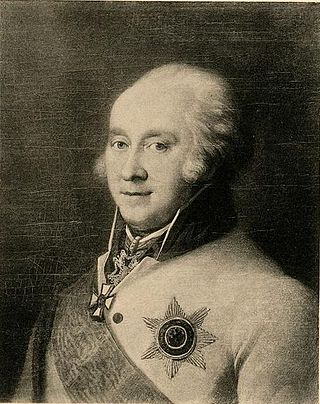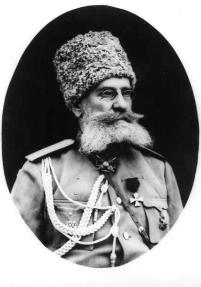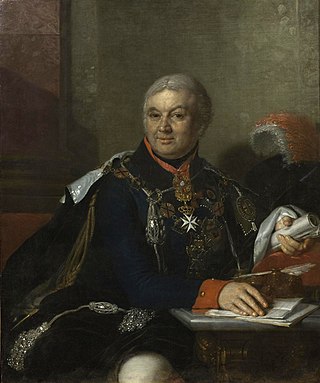Related Research Articles

The Brockhaus and Efron Encyclopaedic Dictionary is a comprehensive multi-volume encyclopaedia in Russian. It contains 121,240 articles, 7,800 images, and 235 maps. It was published in the Russian Empire in 1890–1907, as a joint venture of Leipzig and St Petersburg publishers. The articles were written by the prominent Russian scholars of the period, such as Dmitri Mendeleev and Vladimir Solovyov. Reprints have appeared following the dissolution of the Soviet Union.

The Anrep family is a Baltic-German noble family, belonging also to Swedish and Russian nobility.

Podpolkovnik is a military rank in Slavic and nearby countries which corresponds to the lieutenant colonel in the English-speaking states and military.

Prince Vasily Vladimirovich Dolgorukov was a Russian commander and politician, promoted to Field Marshal (генерал-фельдмаршал) in 1728. His life and fortune swung like a weather vane, due to complex plots and the troubled time following Peter the Great's death.

Prince Valerian Grigoryevich Madatov was a Russian-Armenian prince and a lieutenant-general of the Russian Empire.

Johann von Michelsohnen was a Baltic-German military commander who served in the Imperial Russian Army. He was a prominent general in several wars, but his most noted contribution was his critical role in suppressing Pugachev's Rebellion.

Hussars were first recorded in Russia as groups of irregulars in the mid-17th century. Under Peter I, this class of light cavalry began to serve as organized regiments on a semi-permanent basis in 1723 based on Serbian Hussars out of the Habsburg monarchy. Hussar regiments remained a conscious element of the Imperial Russian Army until the Revolution of 1917.

The 1st Caucasus Army Corps was a military formation of the Russian Empire which existed between 1847 and 1918, including the period during World War I.

Sergey Vasilyevich Belyaev was a major general of the Imperial Russian Army and a brigade commander of the 83th infantry division.
A gradonachalnik was—in the Russian Empire of the 19th and early 20th century—an official with the rights of governor who controlled a gradonachalstvo, independent of the provincial subdivision, with its own administrative unit due to its special significance or geographical location. These cities were Saint Petersburg, Moscow, Odessa, Sevastopol, Kyakhta, Feodosiya, Izmail, Derbent, Rostov-on-Don, Dalniy, Baku, Taganrog, Yalta, Kerch-Yenikale and Nikolayev.
The prime major was the staff officer rank of the Russian Life Guards and the Imperial Russian Army of the 18th century.
The Military Governor was the highest government and military official in a Governorate or Oblast, who was also the commander of troops in his area in the Russian Empire until 1917.

Aleksandr Aleksandrovich Bibikov was an officer of the Imperial Russian Army, who saw service during the Russo-Swedish War and the Napoleonic Wars. He was ambassador to several countries, and also served as a senator in the Governing Senate.

The chinovnik was a Russian title for a person having a rank and serving in the civil or court service. The institution of chinovniks existed de facto in the Tsardom of Russia and the Russian Empire, but until 1722 it did not have a clear structure. The de jure chinovnik institute was structured by the establishment of the Table of Ranks on February 4, 1722.
Peter Ivanovich Chelishchev ; August 14, 1745 – September 25, 1811) was a Russian writer, ethnographer, traveler from the Chelishchev family.

Leonid Nikolaevich Maikov was a prominent researcher in the history of Russian literature, a full member of the Saint Petersburg Academy of Sciences, president of the Russian Bibliological Society, Privy Councillor; the son of the painter Nikolay Maykov, the younger brother of Apollon, Valerian and Vladimir Maykov.

Prince Peter Ivanovich Shalikov was a Russian sentimentalist writer, journalist and publisher.

Zemshchina was in the classical sense, according to the definition of the archaeographer Vasily Storozhev, "land, as a concept opposite to the state, to everything state and sovereign in ancient Russia".

Alexander Andreevich Bekleshov (Bekleshev) (1743–1808, Riga) was a Russian statesman and military figure, an infantry general (1797). Under Paul I twice (in 1799 and 1801) he served as Prosecutor General.
References
- 1 2 Second major // Small Encyclopedic Dictionary of Brockhaus and Efron: in 4 volumes – Saint Petersburg, 1907–1909
- 1 2 Ministry of Defense of the Russian Federation (Ministry of Defense of Russia), Encyclopedia, Second Major
- ↑ Leonid Belovinsky. Illustrated Encyclopedic Historical and Everyday Dictionary of the Russian People. 18th – the beginning of the 20th century. Moscow, 2007, page 609
- ↑ Velovsky // Brockhaus and Efron Encyclopedic Dictionary: In 86 Volumes (82 Volumes and 4 Additional Volumes). Saint Petersburg. 1890–1907
- ↑ Alexander Pushkin. The History of the Pugachev Riot